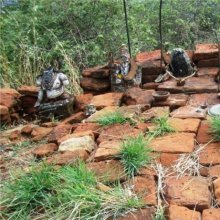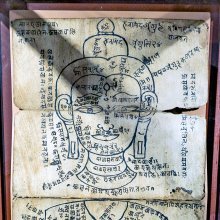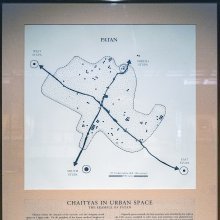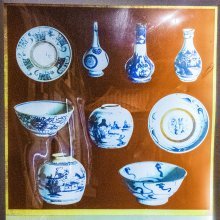Limit, Limiting, Limited: 2 definitions
Introduction:
Limit means something in Hinduism, Sanskrit, biology. If you want to know the exact meaning, history, etymology or English translation of this term then check out the descriptions on this page. Add your comment or reference to a book if you want to contribute to this summary article.
Images (photo gallery)
In Hinduism
Shaivism (Shaiva philosophy)
Source: ORA: Amanaska (king of all yogas): (Shaivism)The Limits (of one’s understanding) is denoted by the Sanskrit term Mita.—In his commentary to the Svacchandatantra (11.197), Kṣemarāja provides the following definition: “Kuhaka is that which causes astonishment and convinces those of limited understanding (mita-hṛdaya). It is chiefly magic”. In his commentary on the Netratantra (18.89), Kṣemarāja glosses kuhakāni as: “Deceitful (things) such as amulets of control, witches, etc.”. These glosses affirm that kuhaka can be understood more specifically to mean an astonishing, magical feat rather than its general sense of something that causes astonishment, the latter definition being that of Dhātupāṭha 10.443.

Shaiva (शैव, śaiva) or Shaivism (śaivism) represents a tradition of Hinduism worshiping Shiva as the supreme being. Closely related to Shaktism, Shaiva literature includes a range of scriptures, including Tantras, while the root of this tradition may be traced back to the ancient Vedas.
Biology (plants and animals)
Source: Google Books: CRC World Dictionary (Regional names)Limits in Kenya is the name of a plant defined with Phoenix dactylifera in various botanical sources. This page contains potential references in Ayurveda, modern medicine, and other folk traditions or local practices It has the synonym Palma major Garsault (among others).
Example references for further research on medicinal uses or toxicity (see latin names for full list):
· The Gardeners Dictionary (1768)
· Matiere médicale (1767)
· Las Variedades Tradicionales de Frutales de la Cuenca del Río Segura: Catálogo Etnobotánico (1997)
· Species Plantarum
· animaux
· Malesia Raccolta (1890)
If you are looking for specific details regarding Limits, for example extract dosage, pregnancy safety, diet and recipes, side effects, chemical composition, health benefits, have a look at these references.

This sections includes definitions from the five kingdoms of living things: Animals, Plants, Fungi, Protists and Monera. It will include both the official binomial nomenclature (scientific names usually in Latin) as well as regional spellings and variants.
See also (Relevant definitions)
Starts with: Limitation, Limited understanding, Limiteda, Limiting adjunct.
Ends with: Tilimit.
Full-text (+1556): Sima, Avadhi, Savadhi, Mita, Maryada, Samaryada, Paramavadhi, Pariccheda, Parimita, Mariya, Parinishtha, Paryanta, Amaryada, Upadhi, Paricchinna, Simita, Kashtha, Vela, Parisime, Savadharana.
Relevant text
Search found 411 books and stories containing Limit, Limiting, Limited; (plurals include: Limits, Limitings, Limiteds). You can also click to the full overview containing English textual excerpts. Below are direct links for the most relevant articles:
Jainism and Patanjali Yoga (Comparative Study) (by Deepak bagadia)
The three Silavratas < [Chapter 3 - Jain Philosophy and Practice]
The five Anuvratas < [Chapter 3 - Jain Philosophy and Practice]
Part 2.5 - Subsidiary Restraints < [Chapter 3 - Jain Philosophy and Practice]
Tattvartha Sutra (with commentary) (by Vijay K. Jain)
Verse 7.29 - The transgressions of the minor vow of limiting possessions < [Chapter 7 - The Five Vows]
Verse 7.30 - The transgressions of Digvirati-vrata (direction-limiting vow) < [Chapter 7 - The Five Vows]
Verse 7.21 - Supplementary vows of the householder with minor-vows < [Chapter 7 - The Five Vows]
The Tattvasangraha [with commentary] (by Ganganatha Jha)
Verse 3627 < [Chapter 26 - Examination of the ‘Person of Super-normal Vision’]
Verse 29 < [Chapter 1 - Examination of the Doctrine of Primordial Matter (prakṛti)]
Verse 2190-2192 < [Chapter 24a - The case for the reliability of the Veda (the Revealed Word)]
Brihad Bhagavatamrita (commentary) (by Śrī Śrīmad Bhaktivedānta Nārāyana Gosvāmī Mahārāja)
Verse 2.2.193 < [Chapter 2 - Jñāna (knowledge)]
Verse 2.2.220 < [Chapter 2 - Jñāna (knowledge)]
Verse 1.5.28 < [Chapter 5 - Priya (the beloved devotees)]
Taittiriya Upanishad Bhashya Vartika (by R. Balasubramanian)
Verse 2.254 < [Book 2 - Brahmavallī]
Verse 2.658 < [Book 2 - Brahmavallī]
Verse 2.80 < [Book 2 - Brahmavallī]
Nyaya-Vaisheshika categories (Study) (by Diptimani Goswami)
Different Types of Quality (Introduction) < [Chapter 4 - Quality and Action]
Substance (6): Kāla (Time) < [Chapter 3 - Dravya (Substance)]
Divisions of Substance < [Chapter 3 - Dravya (Substance)]
Related products
(+16 more products available)










